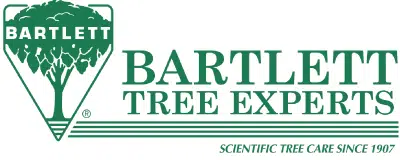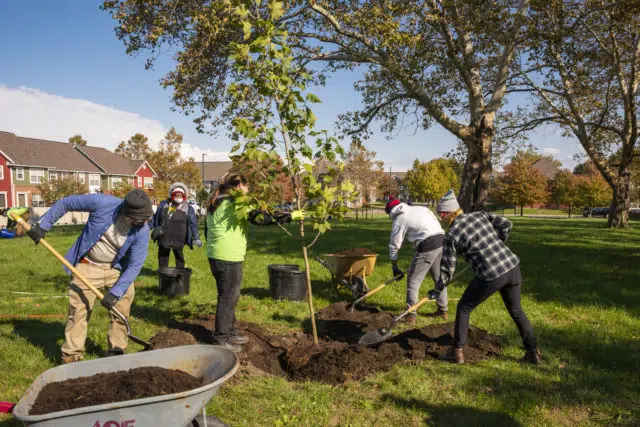
Very few trees die of old age in residential or urban areas—mechanical damage and improper care pose huge threats to trees. If you don’t listen carefully to what your tree is saying, you risk making some mistakes that can shorten or threaten the life of your tree! Here are some reminders, tips, and tricks for keeping your tree happy.
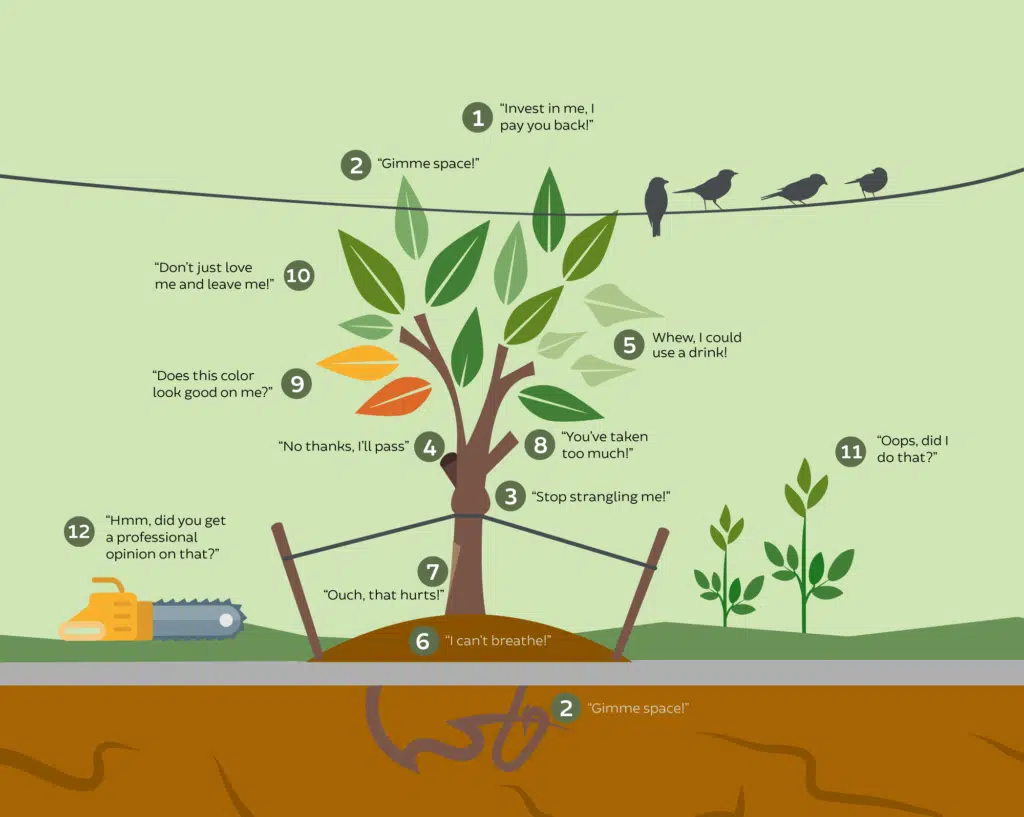
1. “I pay you back!”
Trees are living infrastructure: they pay us back many times over. From increasing property value, offering health benefits, reducing heating and cooling costs, and alleviate flooding and pollution. Like any infrastructure, if not properly maintained, trees will cease to offer their benefits and services and once preventable issues will become problematic when ignored. Tree care is definitely worth it! Read more about tree benefits in our Tree Benefits resource.
2. “Gimme Space!”
Space is crucial to consider before planting… different kinds of trees have different space requirements above and below ground. Overhead wires and very narrow medians are not good conditions for a large shade tree that can grow 50+ feet tall—small trees are better for small spaces. ALL trees need a proper sized planting hole: holes should be dug 2-3 times the width of the root ball and only as deep as the root flare. Learn more about proper planting by watching How to Plant a Tree.
3. “Stop strangling me!”
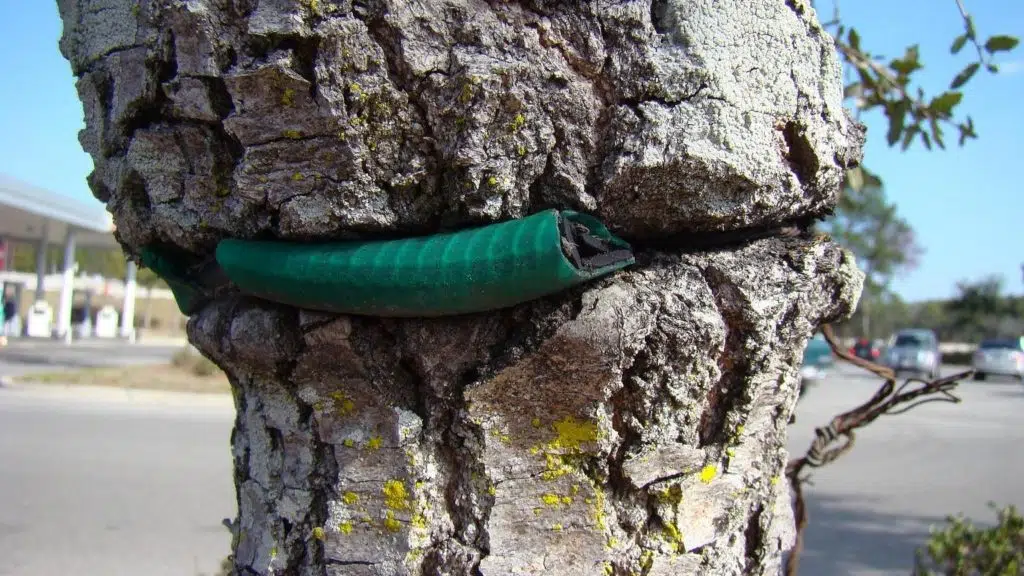
As trees grow, their trunk and branches increase in diameter. If the tree tie, clothesline, hammock, or birdhouse you installed on a tree stays there too long, it will cause damage. The bark will grow around the wire, eventually restricting the sap from flowing through the tree. This results in the killing of all growth above the constriction. To prevent this, flexible ties should be used when staking and removed after one growing season (the sooner the better). If it needs to be staked longer, loosen the wire each spring. Wires, ropes, straps, or cords should NEVER be excessively tightened around the trunk or a branch.
4. “No thank you, I’ll pass!”
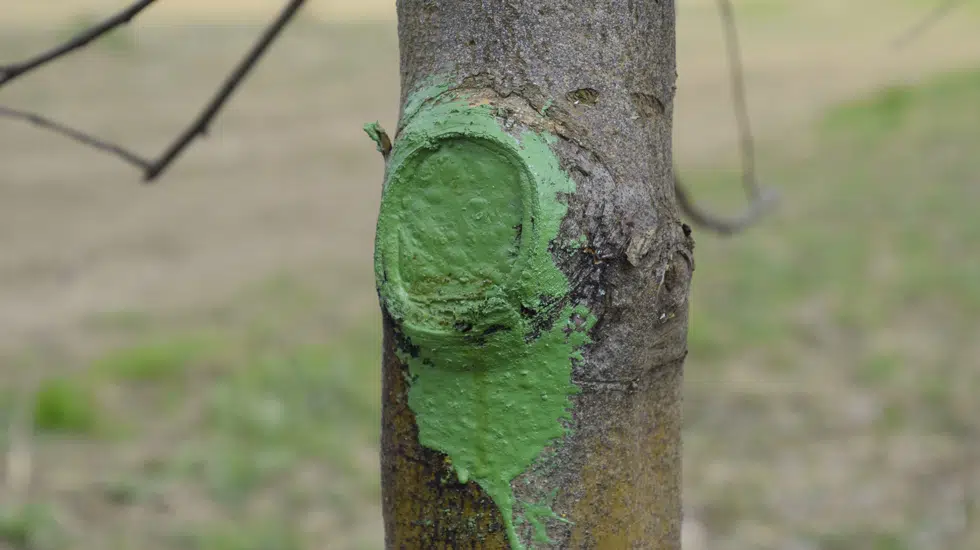
Although bandages may be helpful for treating human wounds, wound paint or the filling of cavities is not something that will typically help a tree. On the contrary, artificial substances can actually hinder healing. In some cases, during the growing months, an arborist might suggest paint to protect an open wound from attracting insects, but this is a call that should be made by a professional—otherwise, just let your tree take its healing into its’ own hands (or, branches)!
5. “Whew. I could use a drink.”

Newly planted trees require a lot of attention the first few years after planting as they expend energy to establish roots in the surrounding soil. Because of this, trees should be watered up to 3 growing seasons after being planted. Established trees should also be watered during dry spells or drought. To check if a tree needs water, dig a few inches into the soil surrounding the root ball and check the moisture. Too much water can be just as bad as not enough. When a tree is thirsty, its leaves will wilt, droop, turn color, look scorched, or even start falling off. For further instructions on how to properly water your tree, read Summer Tree Care Tips: Watering.
6. “I can’t breathe.”

Mulch that is too high or too close to the trunk can cause problems that damage your tree over time. In addition to creating the perfect conditions for root rot, too much mulch can smother the tree’s roots starving them of needed oxygen. In search of air, roots will often grow up through the mulch causing them to “girdle” around the trunk and cut off the water supply. This is a guaranteed way to prematurely kill your tree. Mulch is essential to tree health, but only when applied correctly in a donut shape with the root flare exposed at ground level. Read more on mulching here: The Do’s and Don’ts of Mulching.
7. “Ouch, that hurts!”
The most dangerous pests to trees are humans, particularly with tools in hand. Injuries to trees caused by string trimmers, mowers, etc. are common and often seriously threaten a tree’s health. When trees fall in the path of this equipment, the bark is damaged or even removed thus exposing the critical cambium layer (the transport system). This allows diseases and insects to enter the tree through the wound, or excess moisture which can cause rot. These problems can be avoided by the removal of turf and weeds at the base of a tree and the addition of mulch. This provides a visual cue to keep equipment away from trees. Placing a deer guard around the trunk of the tree adds an extra layer of protection from mowers while also preventing deer from damaging trees with their antlers and stopping rodents from chewing the bark.
8. “You’ve taken too much!”

When done right, pruning keeps trees beautiful and healthy. When done poorly, it can cause irreversible damage. Poor pruning practices include but are not limited to over-pruning, topping, improper cuts, and lion-tailing. Every cut is a wound the tree must recover from. These open wounds create entry points for insects or wood-decaying fungi to enter. Removing branches also impacts future growth, reduces photosynthetic capacity, and takes away stored resources. Because of this, pruning is stressful to a tree and can make it more susceptible to disease. Pruning should always be done with a goal in mind and each cut should be thought out. No more than 25% of branches should be removed in a year . Pruning during the growing season should be avoided. And a proper pruning cut (close but not flush to the trunk) should be made to allow the wound to heal quickly.
9. “Does this color look good on me?”
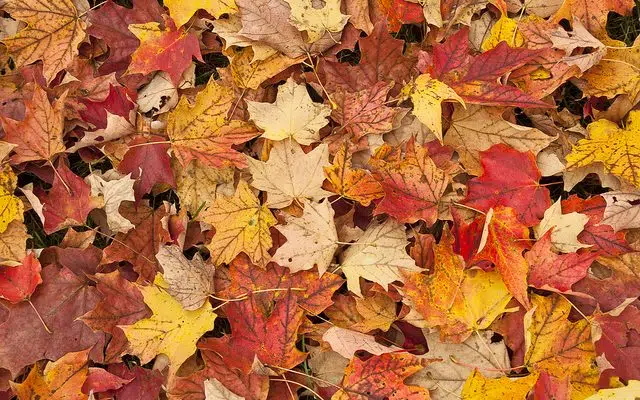
Premature fall color is a sign that your tree is distressed. A tree changes color early as a defense mechanism that saves or diverts energy to combat problems. When trees change color, they are breaking down chlorophyll and directing that energy to other areas of the tree. If one or two branches are discolored, it could mean that they are diseased. Removing the branches will help. If the entire tree is discolored, it is likely a sign of a root-related problem. If you notice this symptom in your trees, be sure to give your tree an inspection for signs of injury.
10.“Don’t just love me and leave me”

There is too much focus on planting trees and too little time spent on how to keep the trees alive and healthy long-term. When trees are young, they need to be trained through pruning to ensure their longevity. By removing branches that are prone to breakage as the tree grows and fostering good branch distribution and structure, you are setting your tree up to be structurally sound, while reducing the need for future maintenance. In addition to this, when a tree is planted, it should be watered and mulched for at least its first 3 growing seasons to ensure proper establishment. After this, inspections of your tree’s well-being should be frequent, whether it is young or old.
11.“Oops… Did I do that?”
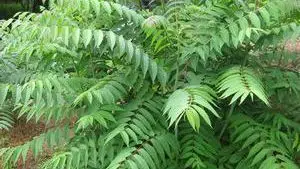
Some trees marketed and sold at nurseries are not good for our neighborhoods and ecosystems. Unfortunately, some trees such as Callery Pear will become weedy and invasive, producing seed that germinates, spreads, and crowds out native diversity. Ensure that the tree you choose is not an invasive exotic tree. Common ‘naughty list’ trees are the aforementioned Callery Pear AKA Bradford Pear, Tree-of-Heaven, and Norway Maple. Please don’t plant these trees!
12. “Hmm… Did you get a professional opinion on that?”
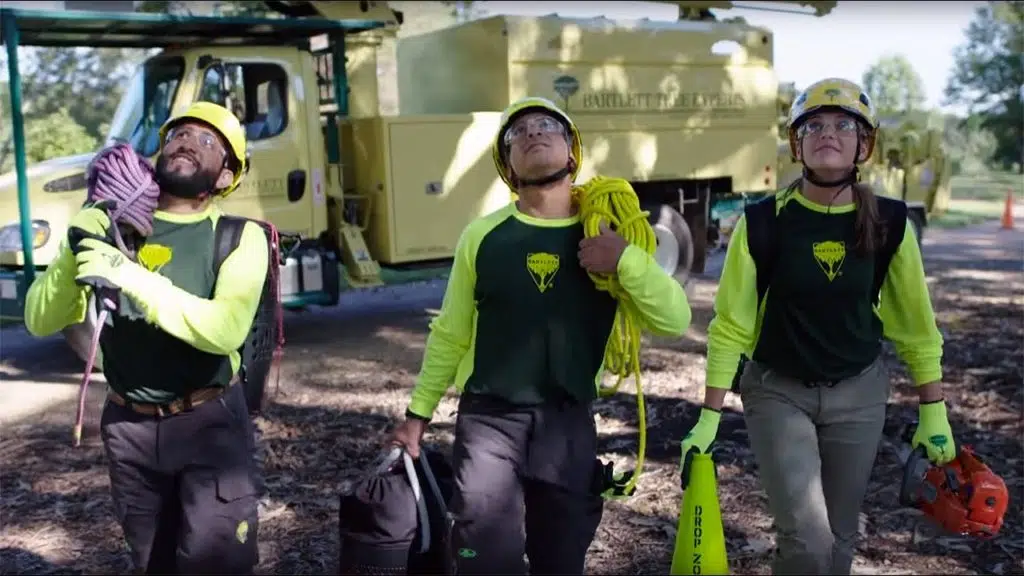
More often than not it is best to call an ISA-certified arborist that is trained in identifying tree issues and can offer numerous solutions. If you are unsure of the health of your tree, it is probably time to consult a professional arborist. If your tree is injured or diseased, a professional can decide what the best course of action is whether that be a type of treatment or removal. Arborists have a large capacity of tools to keep you and your trees healthy and safe, such as cabling, root invigoration, bracing, pesticides, climbing gear, heavy-duty equipment and more. They are happy to help. Call an ISA certified arborist!
Sponsored By:
